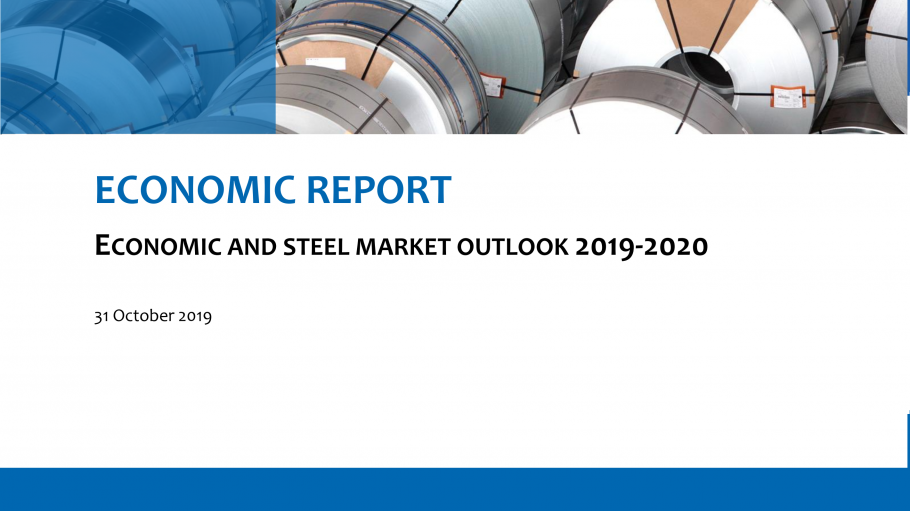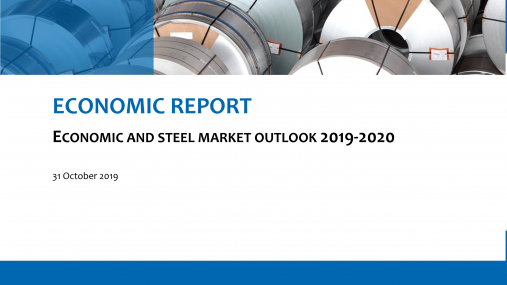
Press releases » Global uncertainty underlies European steel industry vulnerability
Global uncertainty underlies European steel industry vulnerability
Downloads and links
Recent updates

Brussels, 31 October 2019 – Apparent steel consumption fell by 7.7% year-on-year in the second quarter of 2019, after a drop of 1.6% in the first quarter. The negative trend in steel demand is the result of the ongoing slump in EU’s manufacturing sector due to weakened exports and investment that has become more pronounced during the second quarter of this year. Leading indicators forecast a continuation of the downturn for the remainder of the year, with no rebound before the second quarter of 2020.
“The current downslide of the manufacturing sector in the EU is not likely to bottom out soon”, said Axel Eggert, Director General of the European Steel Association (EUROFER). “Escalating trade disputes between the US and several of its main trading partners and persistent uncertainty regarding Brexit could further impact the EU steel industry.”
“We already have to cope with growing import distortions as well as higher volatility as a result of the increase of the EU’s safeguard measures’ quota both this year and next, added Mr Eggert. “Even though imports are slightly down over the year ending in September 2019 compared to the same period in 2018, the import level is still considerably higher than in the reference period for the safeguard. We see an urgent need to further improve the quality of the safeguards and align them with current market conditions”
“In the mid- and long-term perspective, we welcome the announcement of the continuation of the Global Forum on Steel Excess Capacity, supported by an overwhelming majority of G20 and OECD members. We call on China to re-join the Forum urgently. All G20 economies must fulfil their 2016 Hangzhou Summit pledges, which remain an important plank of the G20 agenda”, concluded Mr Eggert.
EU steel market overview
EU28 apparent steel consumption fell by 7.7% year-on-year in the second quarter of 2019 and amounted to 39.3 million tonnes. The stock cycle turned negative in the second quarter of 2019, contrary to the seasonal pattern, which further exacerbated the negative trend in final steel use. In fact, the inventory cycle in the second half of last year showed lower than usual seasonal inventory reductions which resulted in relatively high stock levels in early 2019. Worsening business conditions in the steel-using sectors since the start of this year have triggered a steeper-than-expected reduction in stocks over the second quarter of 2019. The current downturn in steel demand led to a fall of 4% year-on-year in domestic deliveries in the EU in the second quarter of 2019, following a decrease of 3% in the first quarter. After the drop of 1% year-on-year recorded in the first quarter of this year, third country imports decreased considerably in the second quarter (by 19%), and amounted to 8.5 million tonnes, accounting for 21.7% of EU steel demand.
Developments in total imports conceal distortions at the individual product level. These are essentially caused by the design of the current safeguard mechanism, and which has resulted in a rush to maximise quarterly quota allowances by several key exporters to the EU such as Turkey and China. This has been particularly visible for metallic coated sheets for automotive applications, rebar and wire rod.
Since the second quarter of 2019, the challenges that the EU sector has to face have become more severe, with even more negative repercussions on market conditions. After recording falls over the first two quarters of 2019, early indications for the third and final quarter of this year signal a further year-on-year reduction in real steel consumption, resulting in a total decrease in real steel consumption by 0.5% over the year 2019. For 2020 a low-level stabilisation is expected. The expected reduction of apparent steel consumption in 2019 of 3.1% year-on-year and persisting import pressure is, in essence, expected to predominantly penalise EU steel producers in their financial performance.
Market conditions are expected to improve slightly from the second quarter of 2020, although risks related to import distortions and continued global overcapacity are likely to continue undermining the stability of the EU steel market. Apparent consumption is expected to recover in 2020 with a growth rate of 1.4%, basically as a result of a modest re-stocking.
EU steel-using sectors
Business conditions in the manufacturing industry have been deteriorating since the peak of the previous cycle, around the end of 2017. However, there was an acceleration in this downward trend in the second quarter of 2019, particularly in the automotive industry, while the construction sector has continued to record growth in output. This has resulted in a pronounced slowdown in output growth in steel-using sectors. Total output in steel-using sectors fell by 0.2% year-on-year in the second quarter of 2019, having registered positive growth in the first quarter.
The downturn in industrial activity does not only affect Europe, but has reached a global scale, reflecting growing trade tensions and uncertainty – which increasingly hamper business investment. Although a substantial rebound is not in sight, some recovery in EU steel-using sectors is expected over the course of 2020.
However, external risks will continue to cast a shadow over the coming quarters. Global trade fundamentals have clearly changed for the worse, due to the US government’s new tariffs on goods imported from its main trading partners, triggering a retaliation with similar tariffs on US products. As a consequence, the EU’s manufacturing sector is experiencing a serious downturn, given its large exposure to global trade. A no-deal Brexit and a further escalation in protectionist trade measures would make the outlook even more negative. On the other hand, an orderly Brexit and easing trade disputes between the US and its main trading partners would help restore business confidence and support activity in steel-using industries.
Output in the EU’s steel-using sectors is forecast to grow by 0.4% in 2019 and by 0.6% in 2020.
EU economic context
The outlook for the global economy has further deteriorated over the second quarter of 2019 and downside risks have become stronger, coupled with the intensified slowdown in international trade that has considerably affected industrial activity and led to disruptions in downstream supply chains. The EU economy appears to be particularly vulnerable as it is largely exposed to fluctuations in international trade; most of its contribution to growth during the previous cycle came from exports. On the other hand, economic growth, albeit slowing, continued to be supported by final consumption – which has partly offset declining contribution from exports. Services, contrary to the weakness of the industrial sectors, have proven more resilient, also due to the fact that they are far less exposed to both internal and external competition.
The EU economy continues to be subject to downside risks, such as a possible escalation of the trade dispute between the US and its main trading partners, followed by a no-deal Brexit, through a further deterioration in business sentiment and lower investment growth. GDP growth has been slowing down both at the world level and in the eurozone since the peak in the international economic cycle in the second half of 2017. This slowdown has gained speed during 2019, particularly in Germany – the eurozone’s largest economy – as a result of the continued slump in manufacturing in general and the automotive industry in particular. As a result, the EU recorded its lowest year-on-year growth rate since the second half of 2013 in the second quarter of this year. The macroeconomic outlook is not likely to improve significantly, reflecting continued uncertainty and weakness in most industrial sectors, although the EU economy is not expected to slide into a recession thanks to expansionary monetary and – to a lesser extent – fiscal policies.
EUROFER’s third quarter 2019 forecast for EU GDP growth is 1.2% both in 2019 and in 2020.
***
Contact
Charles de Lusignan, Spokesperson and head of communications, +32 2 738 79 35, (charles@eurofer.be)
About the European Steel Association (EUROFER)
EUROFER AISBL is located in Brussels and was founded in 1976. It represents the entirety of steel production in the European Union. EUROFER members are steel companies and national steel federations throughout the EU. The major steel companies and national steel federations in Switzerland and Turkey are associate members.
About the European steel industry
The European steel industry is a world leader in innovation and environmental sustainability. It has a turnover of around €170 billion and directly employs 330,000 highly-skilled people, producing on average 160 million tonnes of steel per year. More than 500 steel production sites across 22 EU Member States provide direct and indirect employment to millions more European citizens. Closely integrated with Europe’s manufacturing and construction industries, steel is the backbone for development, growth and employment in Europe.
Steel is the most versatile industrial material in the world. The thousands of different grades and types of steel developed by the industry make the modern world possible. Steel is 100% recyclable and therefore is a fundamental part of the circular economy. As a basic engineering material, steel is also an essential factor in the development and deployment of innovative, CO2-mitigating technologies, improving resource efficiency and fostering sustainable development in Europe.

Download files or visit links related to this content
Developed with the support of the Offshore Wind Foundation Alliance and European Wind Tower Association, the position paper outlines the strategic importance of wind components for Europe’s green transition and calls for targeted measures to strengthen their role within the NZIA.
Brussels, 2 April 2025 - The latest data unveiled by the OECD in its meeting in Paris draw an extremely worrying picture, where global steel excess capacity is expected to grow from an estimated 602 million tonnes in 2024 to 721 million tonnes by 2027 – over five times the EU's steel production. The European steel industry - already severely hit by the spill-over effects of global overcapacity and the U.S. steel import tariffs - reiterates the crucial need for strict and effective EU post-safeguard measures to ensure its survival.
Brussels, 19 March 2025 – The Steel and Metals Action Plan, unveiled today by the European Commission, provides the right diagnosis to the existential challenges facing the European steel industry. Concrete measures need to follow swiftly to reverse the decline of the sector, re-establish a level playing field with global competitors, and incentivise investment and uptake of green steel in the market.